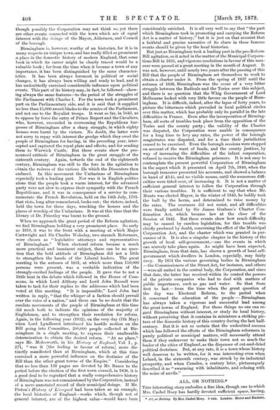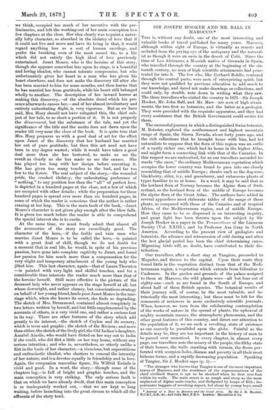ALL, OR NOTHING.* Tins interesting story embodies a fine idea,
though one to which Mrs. Cashel Hoey has hardly devoted sufficient space, having,
• All, or Nothing. By airs. Cashel Hoey. 8 vols. London : Hurst and Hackett. we think, occupied too much of her narrative with the pre- liminaries, and left the working-out of her main conception to a few chapters at the close. Her idea clearly was to paint a natur- ally lofty character, so absorbed in the idolatry of love that if it could not live and move and have its being in that, it would regard anything less as a sort of human sacrilege, and prefer the breaking even of the most sacred tie, to a life which did not satisfy the high ideal of love previously entertained. Janet Molar°, who is the heroine of this story, though she appears somewhat late upon its stage, is a beautiful and loving idealist, who cannot tolerate compromise, but who unfortunately gives her heart to a man who has given his heart elsewhere, and does not make the discovery till after she has been married to him for some months, and then learns that he has married her from gratitude, while his heart still belonged wholly to another. The description of her inward horror at making this discovery,—of the absolute. dread which his pre- sence afterwards causes her,—and of her almost involuntary and entirely unhesitating flight, is very vigorous. But as we have said, Mrs. Hoey should not have relegated this, the chief sub- ject of her tale, to so short a portion of it. It is not properly the olinouontent, but the substance of the tale, and yet the significance of the title and the motto does not dawn upon the reader till very near the close of the book. It is quite true that Mrs. Hoey prepares us with a good deal of art for the effect upon Janet of the discovery that her husband has married her out of pure gratitude, but then this art need not have been in any degree wasted ; while it would have taken a good deal more than she has bestowed, to make us see the result as clearly as she has made us see the causes. She has played too long with her design before executing it. She has given too many touches to the bud, and far too few to the flower. The real subject of the story,—the wounded pride, the crushed idolatry, the unhesitating preference of 4' nothing," to any position less than the " all " of perfect love, is depicted in a hundred pages at the close, not a few of which are occupied with other details ; while the preparation for these hundred pages is spread over more than six hundred pages, in some of which the reader is conscious that the author is rather craning at her leap. This is the main fault of the book,—Janet Monro's character is not given play enough after the blow falls. It is given too much before the reader is able to comprehend the special interest she is to excite.
At the same time, we must freely admit that almost all the accessories of the story are exceedingly good. The character of the hero,—if the feeble and vain man who marries Janet Molar° is to be called the hero,—is painted with a great deal of skill, though we do not doubt for .a moment that in real life, he would, in spite of his previous passion, have gone into complete captivity to Janet, and found her passion for him much more than a compensation for the very slight and temporary attachment of the young lady who jilted him. This last character, again—that of Laura Thornton —is painted with very light and skilful touches, and for a considerable time interests the reader much more than that of the heroine herself. Still more effective is the picture of the deceased lady who never appears on the stage herself at all, but whose downright, and rather clumsy, but conscientious strategy on behalf of her young friend, lands poor Janet Monro in the mar- riage which, when she knows its secret, she finds so degrading. The sketch of Mrs. Drummond, contained almost completely in two letters written by herself, and but little supplemented by the accounts of others, is a very vivid one, and rather a curious feat in its way. There are other features of the story which add greatly to its interest,—the sketch of Ceylon and its scenery, which is terse and graphic ; the sketch of the Riviera; and more than either, the sketch of the lively girl, the Old Indian's daughter, Amabel Ainslie, who would have flirted on her way out to India if she could, who did flirt a little on her way home, without any serious intention ; and who is, nevertheless, so utterly unlike a flirt in the basis of her character,—a vivacious, but superstitious and enthusiastic idealist, who chatters to conceal the intensity of her nature; and is a devotee equally in friendship and in love.
Again, the companion masculine figure, Sir Wilfrid Esdaile is vivid and good. In a word, the story,—though some of the chapters lag,—is full of bright and graphic touches, and the main conception is very striking The only serious fault is that on which we have already dwelt, that this main conception
is so inadequately worked out, —that we are kept so long waiting, before launching into the great stream to which all the ailments of the story tend.



































 Previous page
Previous page